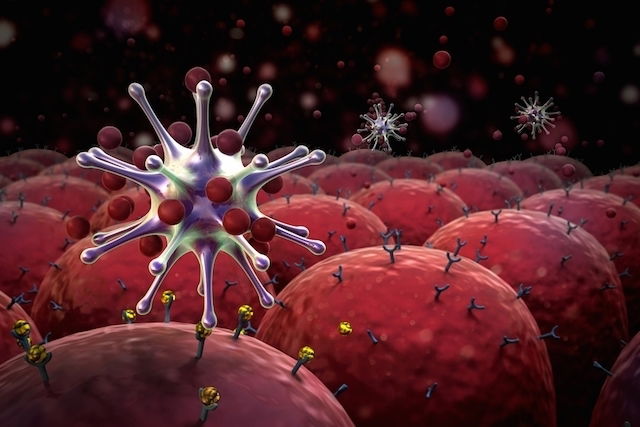Lymphocytes are a type of white blood cell that act as defense cells in the body. They are produced in higher quantities in the presence of an infection, and therefore they can be an indicator of current health status. There are 2 types of lymphocytes: B-cells and T-cells. Each of these play a different role in the immune system.
Lymphocyte levels can be evaluated through a blood test. A high level is normally indicative of infection, while a low level is related to an abnormality within the bone marrow.
It is important for a doctor to assess results alongside their physical exam to determine overall health status and reach a diagnosis. If necessary, the doctor will initiate treatment.

Lymphocyte abnormalities
Normal lymphocyte levels are usually between 1000 to 2900 lymphocytes per mm³ of blood, which represents 20 to 50% of the relative concentration. Set reference ranges can vary from lab to lab. When levels are above or below the reference ranges, they are referred to as lymphocytosis (for increased levels) or lymphopenia (for low levels).
1. Low lymphocytes
Lymphocytes that are below references ranges are referred to as lymphopenia. Low levels are usually related to bone marrow abnormalities, like aplastic anemia or leukemia. Lymphopenia can also be a sign of an auto-immune disease, in which the body attacks its own immune system, as seen in lupus.
Lymphopenia can also occur with AIDS, during treatment with immunosuppressant medication, chemotherapy, radiation therapy, rare genetic diseases or stressful situations (like during post-op phases or following strenuous activity).
Decreased lymphocyte counts have also been noted in COVID-19 patients, as the presence of this virus can destroy lymphocytes.
2. High lymphocytes
Lymphocyte levels that are above the reference ranges are referred to as lymphocytosis. This is a common finding for patients presenting with symptoms of an infection. The main causes of high lymphocytes are:
- Acute infections, like mononucleosis, poliomyelitis, measles, rubella, dengue or pertussis.
- Chronic infections, like tuberculosis or malaria
- Viral hepatitis
- Hyperthyroidism
- Pernicious anemia, which is characterized by a lack of folic acid and vitamin B12
- Overdose of benzene or other toxic metals
- Diabetes;
- Obesity
- Allergies
In addition, the increased number of lymphocytes can also increase due to physiologic changes from pregnancy or breastfeeding. It can also be a result of nutritional deficiencies, like lack of vitamin C, vitamin D or calcium.
Types of lymphocytes
The body produces 2 types of lymphocytes: B-lymphocytes (which are immature cells produced in the bone marrow and released to the bloodstream to make antibodies to fight bacteria, viruses and fungi) and T-lymphocytes (which are produced in the bone marrow and develop in the thymus).
Developed T-lymphocytes can be further categorized into 3 groups:
- CD4 T-lymphocytes: these help the B-lymphocytes to eliminate infections. They are the first line of defense of the immune system. These are usually the main cells that are affected with HIV as those who are infected will usually have a CD4 level of less than 100/ mm³
- CD8 T-lymphocytes: These decrease the activity of other types of lymphocytes and are noted to be increased in cases of HIV
- Cytotoxic lymphocytes: these destroy abnormal cells or cells that are infected by viruses or bacteria
All lymphocyte tests, especially CD4 or CD8 tests, should always be interpreted by a doctor to evaluate for the presence of illnesses, like HIV.
Atypical lymphocytes
Atypical lymphocytes are lymphocytes that present with varied shapes. These usually emerge with infections, particularly viral infections like mononucleosis, herpes, AIDS, rubella and varicella. Atypical lymphocytes can also be noted on blood tests during bacterial infections (like tuberculosis, and syphilis), protozoan infections (like toxoplasmosis), when there is a hypersensitivity to medications, or with auto-immune diseases (like lupus).
Normally these lymphocyte levels will return to normal (which is 0%) after the foreign invader is eliminated.
These lymphocytes are considered to be active T-lymphocytes that are produced in response to infected B-lymphocytes. They work the same as typical lymphocytes, although they are generally larger and have different shapes.
